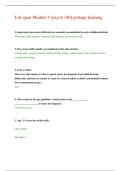Life span Module 4 (psych 140) portage learning
1. Important gross motor skills that are normally accomplished in early childhood include
Throwing a ball, hopping, catching a ball, running, and kicking a ball
2. Fine motor skills usually accomplished at this time include
Cutting paper, pasting, pouring, building blocks, lacing, cutting along a line, printing a name,
tracing, and coloring
3. True or False:
There are wide ranges of what is typical motor development. Each child develops
differently, and there is usually no cause for concern unless a child is substantially behind
the recommended ranges.
True
4. The overlap in the age guidelines, which points to the _____________
___________________ of motor development.
Continuous nature
5. Age: 2-3 years has which skills.
Gross Motor
Fine Motor
,Can jump. Can throw and catch a ball, although the upper body remains rigid.
Can zip and unzip. Can use a spoon.
6. Age: 3-4 years has which skills.
Gross Motor
Fine Motor
Can walk upstairs, alternating feet on each step. Can walk downstairs leading with one foot. Can
throw and catch a ball (although catching usually involves trapping the ball against the chest)
Can use child scissors. Can fasten and unfasten large buttons.
7. Age: 4-5 years has which skills
Gross Motor
Fine Motor
Can walk upstairs and downstairs, alternating feet. Can catch a ball with hands
Can use a fork well. Can cut on a line using scissors
8. Age: 5-6 years has which skills
, Gross Motor
Fine Motor
Can skip. Can ride a bicycle with training wheels
Can tie shoes. Can copy some numbers and basic words.
Other physical changes include
The types of brain development mentioned in Module 3
9. A primary type of neural growth during early childhood is the further development of
connections between neurons. These connections take place where?
At the synapse or space between neurons.
10. Additional brain development occurs in early childhood. First, _______________ begins.
Myelination
11. What is the meaning of myelination?
Some neurons become insulated with a layer of fat. This fat layer essentially serves as lubrication
to speed up messages being relayed among neurons.
This process takes many years, and it has a direct impact on the thinking process of young
children




